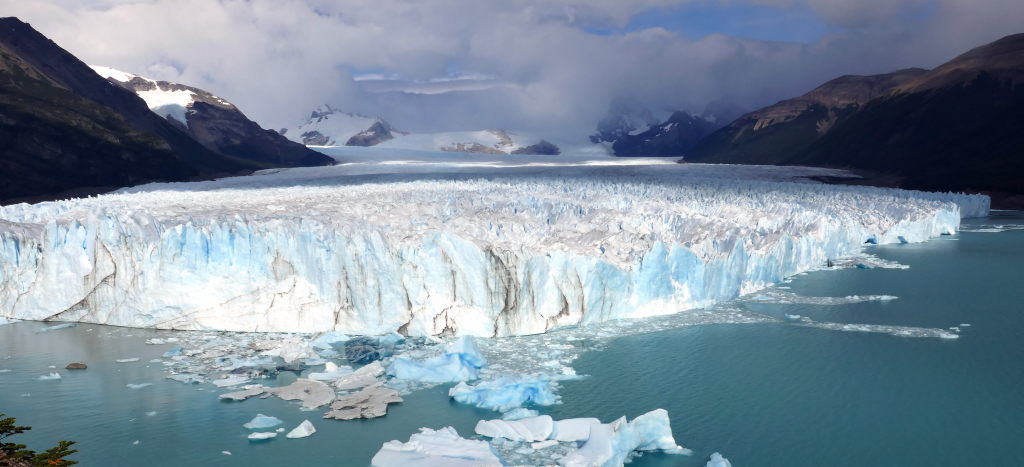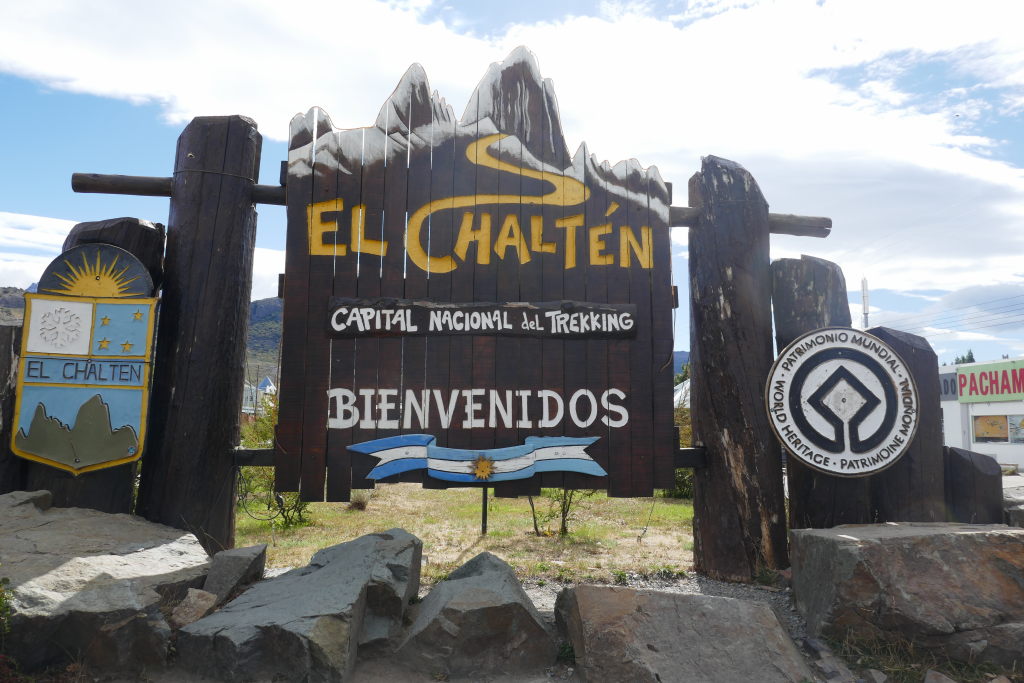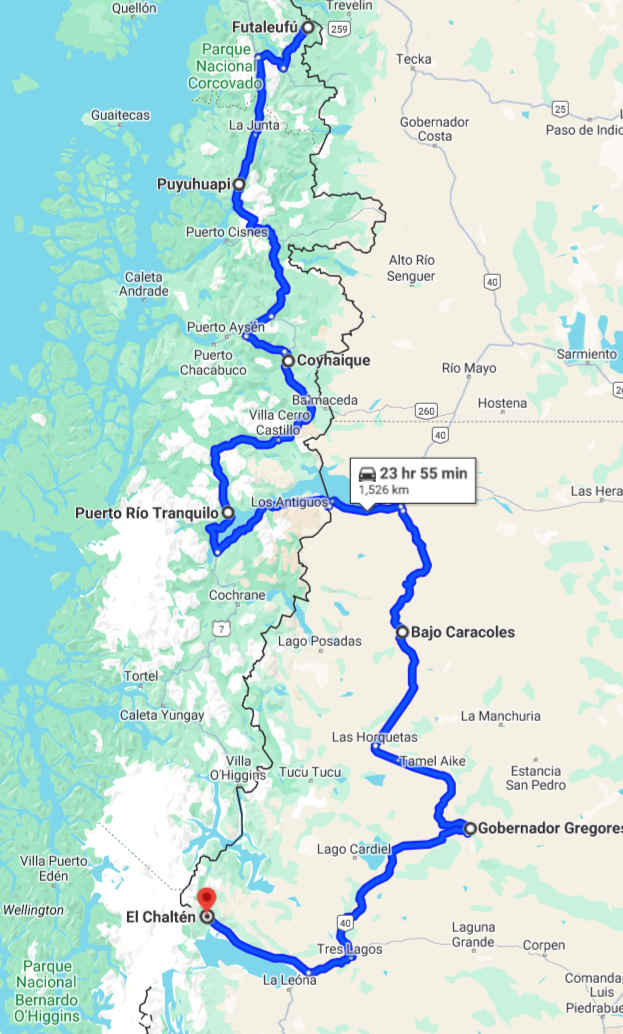Go to South America 24: Day 29Go to South America 24: Day 22Go to South America 24 Day 1
Day 37: El Calafate
Afer a great day of hiking in El Chalten I rode to El Calafate, the town that is the gateway to the Perito Moreno glacier. A bit over 200 kms between the two towns and tarmac’ed the whole way. I found a hostel that had off street parking for the bike and had a private room available. It’s pretty basic with a minimal kitchen, however, it has heated flooring! Very nice. After sleeping rather badly, I rearranged the loading of the bike for a return trip to the Perito Moreno glacier staying at the same hostel for two nights. The glacier is 250 sqr kms in size and together with the 47 other glaciers in the area holds 1/3 of the freshwater in the world! The glacier is nor shrinking or expanding meaning it is fed the same amount of snow as it is loosing, The glacier grows in the months of June through December and recedes between December and April. Glacioligists debates the reason for the glacier being in equilibrium with other glaciers in the world, often, shrinking.




The height of the ice at the highest point is 70m. The glacier advances two meters every day, and calves every minute and I heard several of these events giving up an almighty roar every time. Very impressive!After spending 3.5 hours at the site I packed the bike and rode back to El Calafate and the hostel.
Day 39: Puerto Natales

After the impressive glacier sightings, I moved on towards the south and Puerto Natales, which is the gateway to the Chilean “equivalent” of El Chalten, Torres del Paine. Along the way I see a lot of Guanacos which is a smaller relative of the domesticated Llama. There are fences 50m on either side of the road but the Guanacos get over them easily and often forage close to the road. They get to be 1.2 m tall and weigh close to 100 kg so you definitively do not want to hit one. I need to relax some more so I will definitively stay two nights at this nice hotel like hostel, Sendero.


I have plans to make a day-trip to Torres del Paine, but unfortunately, it’s raining quite heavily today and the forecast for the next few days does not look promising so I’ll spend my time in front of the Woodburner.
Day 41: Cerro Sombrero
With no good weather in the forecast for the next few days, I got on the bike and rode to Tierra del Fuego. It was a very windy day which made riding feel dangerous with the bike tilted over one way for all of a sudden the wind changing direction making the bike tilt the other way. Not enjoyable riding at all!To get to tierra del fuego you must take a ferry and I chose the shorter and more regular option leaving the mainland at Punta Delgado. While waiting for the ferry to arrive the wind was very strong and I was worried the bike would be blown over. Scary stuff you never think of when traveling in a car.After an hour the ferry arrived and it was really struggling against the wind to get to the loading position. On board the ferry without problems I had an hour for some refreshments before getting off on Tierra del Fuego.


I carried on until I got to Cerro Sombrero where I stopped to fill the tank. I asked the attendant the directions to a hotel and I found a really nice and cozy one, hosteria Tunkelen, and they had a room. I had dinner with a guy who is organizing motorcycle tours in South America. He was returning from Ushuaia after having guided a group of bikers on a 23 day trip. He would soon be guiding a group of Italian bikers organized through Dainese. This was his job! The envy of many bikers, I’m sure!

Hosteria Tunkelen
Day 42: Ushuaia
I was considering staying another day at Tunkelen hosteria and wait for a less windy day, but in the end I decided to go, It’s a 400 km ride, first through Chile and then Argentina. It was very windy until the last 100 kms, with the last 50 kms going through mountainous terrain over Paso Garibaldi, and, of course, it started raining and the temperature sank to 4C. It was so cold on the bike! But I made it 🙂
![]()
I rode around town to find somewhere to stay and in several places they were full, I finally found a 2-star hotel close to the center, Hotel Vitalia.
The Yamana people were the first inhabitants of the island and were, perhaps, in some respects similar to Eskimos, in that they lived in a pretty harsh environment. Apart from one difference – they didn’t wear clothes!

They used bonfires to keep warm and when Magellan came there in 1520 he saw the fires and named the island Tierra del Fuego! With more European influence the indigenous people started to suffer, wearing clothes meant that their hygiene got worse and many caught European illnesses such as measles and perished.
Eventually the Argentines settled the area and built a jail for serious criminals, which has now been converted to a museum where I got the picture of the Yamani people. Ushuaia is today a prosperous city of 80,000 people.Weather is mild with average -1 degrees in the dead of winter.Tourism is a big part of the economy with cruise ships often seen in the harbor.


Day 44: Cerro Sombrero
I stayed in Ushuaia for two days and then started on the ride back north. It was cold and very wet for a while, and later on strong winds. When I arrived at the hotel I was frozen to the bone and not even a hot bath could revive the circulation in my feet. Oh dear, the pleasures of adventure riding 🤔At dinner I chatted to a group of bikers and understood that one of the riders had crashed and was at the local clinic being checked out. He had no broken bones but was in some pain. Luckily, the group had a follow-along truck and he would be riding there rather than on his bike. I decided to stay for an extra day to thoroughly warm up and consider my plans.
In the morning I talked to my 8 year old girl and when I told her it was possible to end the trip and come home within a week she said, yeah!I missed you!
I have been told by many that the trip north along Ruta 3 is incredibly boring and 3000 kms in distance.Taking everything into consideration I decided to end the trip in Punta Arenas where the bike will be trucked to Santiago and then shipped to Singapore.
Day 46: Punta Arenas
The ride of the 200 kms was very cold and windy with a temperature at the start of 5c. There was nowhere to warm up until 160kms along the way, and I was really glad to stop for an empanada and hot coffee and warm up by a radiator!
In Punta Arenas I had to find a notary to make a power of attorney allowing my shipping agent to handle customs on my behalf when shipping the bike to Singapore. There are many notaries in every town and it didn’t take long to find one and get the required document.Then off to the trucking depot where I left the bike after packing all my bike clothes on the bike leaving me with only cabin luggage for the flights back to Singapore.

The next day I walked around town for a while before getting to the airport and the flight to Santiago.



The flight is 3 and a half hours reflecting the distance I’ve covered which was 6000kms! Quite a way.

Progress to Ushuaia and back to Punta Arenas.
Day 47: Santiago
I landed in Santiago and found a Best Western hotel in the Centro area. The hotel room is nice but the localtion not so great with no restaurents or caffes anywhere near. Neither is the hotel at a safe area and I was told to stay inside after dark which kind of meant I had to have dinners at the hotel. For the next three datys I did some sightseeing but saw nothing very exciting.
![]()
![]()
![]()
![]()
![]()
![]()
After 3 days in Santiago it was time to get on the plane to Houston, followed by legs to San Fransisco and Singapore. The last leg is a 17 hour killer flight. Not much fun being stuck in a chair for that long.



















 As I walk around this and other towns I can’t help but notice streets and areas with the name “O’Higgins”. This doesn’t sound very Chilean or even Spanish so who was this man? It turns out that he is considered the father of independent Chile. He had Irish and Spanish ancestry and he was instrumental in freeing Chile from Spain in the early 1800s.
As I walk around this and other towns I can’t help but notice streets and areas with the name “O’Higgins”. This doesn’t sound very Chilean or even Spanish so who was this man? It turns out that he is considered the father of independent Chile. He had Irish and Spanish ancestry and he was instrumental in freeing Chile from Spain in the early 1800s.


























